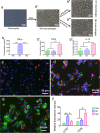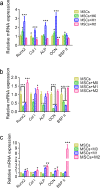Macrophage type modulates osteogenic differentiation of adipose tissue MSCs
- PMID: 28361303
- PMCID: PMC5552848
- DOI: 10.1007/s00441-017-2598-8
Macrophage type modulates osteogenic differentiation of adipose tissue MSCs
Abstract
Since the reconstruction of large bone defects remains a challenge, knowledge about the biology of bone healing is desirable to develop novel strategies for improving the treatment of bone defects. In osteoimmunology, macrophages are the central component in the early stage of physiological response after bone injury and bone remodeling in the late stage. During this process, a switch of macrophage phenotype from pro-inflammatory (M1) to anti-inflammatory (M2) is observed. An appealing option for bone regeneration would be to exploit this regulatory role for the benefit of osteogenic differentiation of osteoprogenitor cells (e.g., mesenchymal stem cells; MSCs) and to eventually utilize this knowledge to improve the therapeutic outcome of bone regenerative treatment. In view of this, we focused on the in vitro interaction of different macrophage subtypes with adipose tissue MSCs to monitor the behavior (i.e. proliferation, differentiation and mineralization) of the latter in dedicated co-culture models. Our data show that co-culture of MSCs with M2 macrophages, but not with M1 macrophages or M0 macrophages, results in significantly increased MSC mineralization caused by soluble factors. Specifically, M2 macrophages promoted the proliferation and osteogenic differentiation of MSCs, while M0 and M1 macrophages solely stimulated the osteogenic differentiation of MSCs in the early and middle stages during co-culture. Secretion of the soluble factors oncostatin M (OSM) and bone morphogenetic protein 2 (BMP-2) by macrophages showed correlation with MSC gene expression levels for OSM-receptor and BMP-2, suggesting the involvement of both signaling pathways in the osteogenic differentiation of MSCs.
Keywords: Cell culture model; MSC; Macrophage; Osteogenic differentiation.
Conflict of interest statement
Conflict of interest
The authors have no conflict of interest to disclose.
Funding
This study was financially supported by The Netherlands Organization for Health Research and Development (ZonMw, project number 40-41400-98-1401) and China Scholarship Council (No. 2010622061).
Figures







Similar articles
-
Coculture with monocytes/macrophages modulates osteogenic differentiation of adipose-derived mesenchymal stromal cells on poly(lactic-co-glycolic) acid/polycaprolactone scaffolds.J Tissue Eng Regen Med. 2019 May;13(5):785-798. doi: 10.1002/term.2826. Epub 2019 Apr 5. J Tissue Eng Regen Med. 2019. PMID: 30771241 Free PMC article.
-
The Macrophage Polarization Regulates MSC Osteoblast Differentiation in vitro.Ann Clin Lab Sci. 2016 Winter;46(1):65-71. Ann Clin Lab Sci. 2016. PMID: 26927345
-
Donor Site Location Is Critical for Proliferation, Stem Cell Capacity, and Osteogenic Differentiation of Adipose Mesenchymal Stem/Stromal Cells: Implications for Bone Tissue Engineering.Int J Mol Sci. 2018 Jun 26;19(7):1868. doi: 10.3390/ijms19071868. Int J Mol Sci. 2018. PMID: 29949865 Free PMC article.
-
Mesenchymal stem cell-macrophage crosstalk and bone healing.Biomaterials. 2019 Mar;196:80-89. doi: 10.1016/j.biomaterials.2017.12.025. Epub 2018 Jan 2. Biomaterials. 2019. PMID: 29329642 Free PMC article. Review.
-
Mesenchymal stem cell-associated lncRNA in osteogenic differentiation.Biomed Pharmacother. 2019 Jul;115:108912. doi: 10.1016/j.biopha.2019.108912. Epub 2019 Apr 29. Biomed Pharmacother. 2019. PMID: 31048188 Review.
Cited by
-
[Early effect of graphene oxide-carboxymethyl chitosan hydrogel loaded with interleukin 4 and bone morphogenetic protein 2 on bone immunity and repair].Zhongguo Xiu Fu Chong Jian Wai Ke Za Zhi. 2020 Aug 15;34(8):1044-1051. doi: 10.7507/1002-1892.201911068. Zhongguo Xiu Fu Chong Jian Wai Ke Za Zhi. 2020. PMID: 32794677 Free PMC article. Chinese.
-
Calcium silicate enhances immunosuppressive function of MSCs to indirectly modulate the polarization of macrophages.Regen Biomater. 2021 Oct 22;8(6):rbab056. doi: 10.1093/rb/rbab056. eCollection 2021 Dec. Regen Biomater. 2021. PMID: 34804588 Free PMC article.
-
Immunomodulatory Properties and Osteogenic Activity of Polyetheretherketone Coated with Titanate Nanonetwork Structures.Int J Mol Sci. 2022 Jan 6;23(2):612. doi: 10.3390/ijms23020612. Int J Mol Sci. 2022. PMID: 35054795 Free PMC article.
-
The spatial form periosteal-bone complex promotes bone regeneration by coordinating macrophage polarization and osteogenic-angiogenic events.Mater Today Bio. 2021 Sep 17;12:100142. doi: 10.1016/j.mtbio.2021.100142. eCollection 2021 Sep. Mater Today Bio. 2021. PMID: 34647005 Free PMC article.
-
Isolation of High Purity Mouse Mesenchymal Stem Cells through Depleting Macrophages Using Liposomal Clodronate.Tissue Eng Regen Med. 2022 Jun;19(3):565-575. doi: 10.1007/s13770-021-00412-6. Epub 2022 Jan 1. Tissue Eng Regen Med. 2022. PMID: 34973125 Free PMC article.
References
Publication types
MeSH terms
Substances
Grants and funding
LinkOut - more resources
Full Text Sources
Other Literature Sources
Molecular Biology Databases

